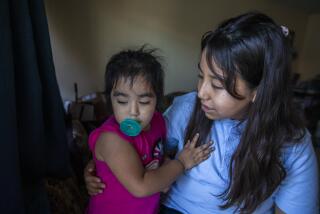THE NEXT LOS ANGELES / TURNING IDEAS INTO ACTION : Values : How do you teach your child values when it’s on the list with ‘find another job,’ ‘get some sleep’ and ‘do the laundry?’ : Solutions : BALANCE CHILDREN’S ACTIVITY SCHEDULE
- Share via
FROM: Reginald Clark, founder of the Montclair-based Reginald Clark and Associates and consultant to school districts nationwide on how to increase the success of low-achieving students.
Sociologist Clark, 44, was born in Chicago, the oldest of five children in a family headed by a single mother, and grew up to earn two master’s degrees and a doctorate from the University of Wisconsin. Because of his experience and observations, he questioned the prevailing wisdom that children’s development and academic success could be explained by family structure, economics or whether their mothers worked. He came to believe that those who succeeded were more active than those who failed and that the successful ones also received the support of active networks of adults in their schools and neighborhoods.
Clark calls for programs to give children a “balanced activity schedule.”
They are awake 90 to 100 hours a week, in school 30 hours a week and have roughly 70 more hours to fill. At least 35 of those hours should be spent in “high-yield activities” that can be applied later to schoolwork: studying, homework, reading, writing, hobbies, lessons, working on computers or visiting museums.
Two to five hours should be devoted to chores or volunteer-type activities that promote responsibility. The other time can be spent in activity that nurtures body, mind and spirit: eating, hygiene, free play, watching TV, hanging out with friends, shopping for fun, playing, daydreaming, meditating, praying.
In studies, Clark found that youngsters who score at or above national norms spend half their free time on constructive activities. But adult networks are critical to support them.
To build up that network in a certain school district, his assistants help build relationships between educators and students. They may help teachers understand their biases and stereotypes about the parents of low-achieving students or help them manage children’s behavior.
They also help link the students to other adults in the neighborhood who can serve as mentors, coaches or tutors.
Like many other child advocates, he encourages the buildup of programs like youth clubs, reading programs in libraries and after-school enrichment programs in schools.
*
REALITY CHECK:
Two schools in Pasadena that used Clark’s model saw dramatic results, rising from among the lowest-scoring schools to the top for their income bracket, he said. His model is being implemented in Bakersfield and five neighborhoods in Nashville, Tenn.
School districts can implement such programs at relatively low cost. And private funding sources can be tapped for teacher and parent training programs and to help underwrite after-school activities.
*
“The bottom line is where the family leaves off, other adults have to pick up and ensure that the student does get that access to 30 hours a week or more of constructive activity. . . . It’s do-able. It’s just a matter of having the insight and the will.”






